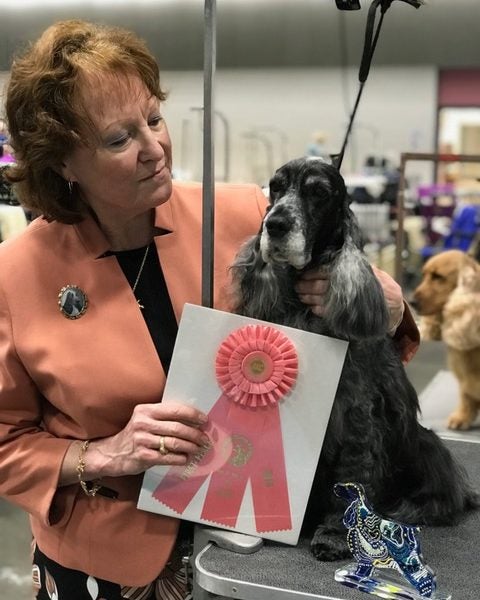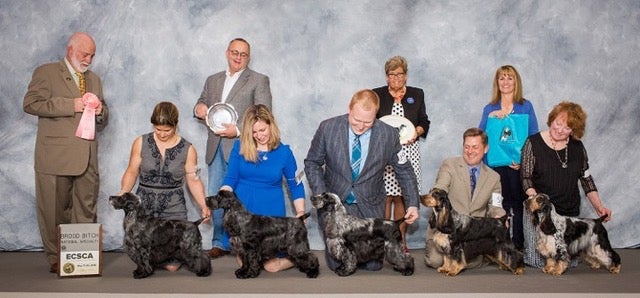
People in the sport of dogs can wear many hats, and Bonnie Threlfall of Cary, North Carolina, has pretty much donned them all: Born into a dog-show family, she has been breeding her Edgewood English Cocker Spaniels for more than 40 years. After a decade-long stint as a professional handler in the late 1970s into the ’80s, she began her judging career almost 20 years ago.
Threlfall judges the Sporting and Hound groups, as well as a smattering of other breeds across various groups. In between, she finds time to breed a litter every year or two with her son Evan and his wife Stacy, themselves both professional handlers who attend dog shows with Threlfall’s two grandsons, who can often be found snoozing on comfy quilts in their playpen among the dog crates.
Here, Bonnie Threlfall talks about how she was smitten by the English Cocker, why finding a puppy can be a challenge, and her best tip for newbies to the sport.
Family affair
My godmother had group- and national-specialty-winning Samoyeds in the 1940s and ’50s, and she introduced my dad to the dog-show world. He had Labrador Retrievers, so I grew up in the sport.
Good things, small packages
I will always love Labs, but if I was going to be an occasional breeder, they were just too big and had too many puppies — at least, that was my thinking as a teenager. I also had an Irish Water Spaniel who was the great-grandmother of the 1979 Westminster Best in Show winner Ch. Oak Tree’s Irishtocrat, but the same applied to that breed.
I grew up on Long Island, which at the time was a hotbed of dog-show activity, and I knew a lady who bred English Cockers. As a breed, they were very appealing. Their size was nice, but they were still very sturdy — you’d be surprised at how much they weigh, a good 30 pounds — and they have just enough hair to be attractive.

Supply and demand
In England, English Cockers are very popular, but it’s the exact opposite here. Generally, people only know about the breed through word of mouth. The average litter size is five, and we only breed to have another dog to keep going with. They only come in season once a year, and sometimes even longer than that. As a result, we never have enough puppies to go around.
Biggest misconception among pet owners
Because they have less hair than an American Cocker, some people think there is less grooming involved with English Cockers. In reality, the hair needs to be stripped out, which, if you do it correctly, doesn’t take a small amount of time. It’s a lot of maintenance. I think it’s worth it — most days. Most pet people just use a clipper.
Biggest misconception among show people
That they should look like a miniature Setter. They think the English Cocker should be a racy, narrow dog when in actuality it’s the opposite — this should be a big-bodied, big-ribbed, short-coupled, sturdy, sturdy dog.
Field notes
When the breed was developed, there was no refrigeration, so the dogs only needed to bring back a bird or two. But in today’s field trials, the focus is on speed, and the number of birds brought back, which is entirely different from the breed’s original purpose: Being fast doesn’t help you when you’re barreling through five-foot-tall briars and pushing through deep thickets to flush a bird. The AKC Working Test, which many of our show dogs do, is much more like the original conditions for the breed.
Why be an AKC Breeder of Merit?
At its most fundamental, to separate the ethical, preservation breeders from the strictly for-profit breeders.
Puppy 911
I am always available to help and answer questions. My puppy people know that I will always take one of my puppies back, no matter how old the dog is, should unforeseen circumstances occur. I always send birthday greetings to all of my puppies, so that I am in touch at least once a year for their lifetimes.
Food for Thought
While they are a very kind and gentle breed, English Cockers are also extremely food oriented. Many people say that about their breed, but I don’t know many breeds that would fly into a feeding frenzy at the toss of a piece of plain iceberg lettuce.
Most Common Breeder Error
This is a very sweet breed, so much so that a show dog will not thrive as a kennel dog — it has to be a pet, too. As a result, many owners aren’t able to unbiasedly evaluate their dog for it’s their strengths and weaknesses. Also, as the breed comes in many colors and some patterns, breeding choices are made on color desires and not conformation quality.
Forward Thinker
I do a breeding with two or three future breedings in mind. My goal is to improve my dogs while doing the breed no harm. I look for a stud dog, and then I look at his pedigree. If I wonder how such a nice dog came from that pedigree, I will pass on using him.
Priority in the Ring
I’m interested in judging any breed as a breeder would — I’m not just looking for a great show dog. If I have a class where the quality isn’t great, and I’m struggling, I ask myself: “What if these were the last three left in the world? If I’m bringing back the breed, which one would I use?”
Words of Wisdom for Newbies
Understand that the breed did not begin at the time you got your first dog. It is so important to collect as many old books and magazines about the breed as possible and to read and absorb them. Go to as many specialties as possible, touch as many dogs as possible (not just ones related to your dog), keep your mouth shut, and just listen.
Learn more about the Breeder of Merit program.

